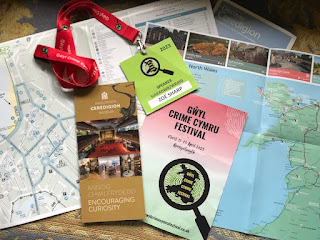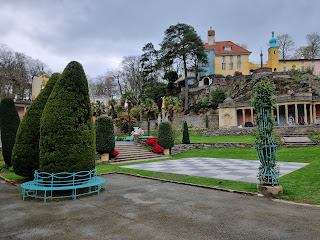Gŵyl Crime Cymru Festival and Portmeirion
There’s something soulful about being near the sea. I rather miss no longer living close enough to smell the salt water or hear the rhythmic rush of waves on a shingle beach. Even the cry of seagulls makes me come over all nostalgic and a little misty-eyed.
So last weekend—April 21st-23rd—I was delighted to find myself at the western edge of Wales, in Aberystwyth for the Gŵyl CRIME CYMRU Festival. The Festival was split between two venues in the town—both a stone's skip from the seafront. One was the rather splendid Public Library, on Queen’s Square. The other was just along Portland Street at the Ceredigion Museum.
The museum is located in an old Edwardian theatre, with a grand staircase and intact auditorium. Because it’s actually two buildings now knocked into one, getting from one floor to another was not as straightforward as you might think. Indeed,
(And, of course, as every good crime writer knows, the clew of thread—as given to Theseus by Ariadne to help guide him out of the labyrinth on Knossos after slaying the minotaur—gave rise to the modern word clue.)
But I digress.
I was fortunate enough to be invited to take part in the
Is it any wonder I really like this woman?
 |
| (l to r) Zoë Sharp, Caro Ramsay, Sarah Ward |
The Festival was packed with interesting events, from the Dragon Parade along the promenade (dragon-based paraphernalia optional) to the murder mystery play that was performed during the interval in the Gala Quiz on Friday evening. There were several panels or workshops delivered solely in the Welsh
The local branch of Waterstone’s, run by the delightful Chloe Tilson, was in charge of the book room, where they were happy to take the indie authors’ books on consignment, and made a point of getting all the stock copies they’d brought with them signed by attendees. Such a nice touch.
 |
| Zoë Sharp and Friend. (Pic courtesy of Waterstones Aberystwyth) |
Meanwhile, authors not yet published had an opportunity to pitch to agents, and there were online events in the run-up to the weekend. Even the local bars got into the spirit of things (pun intended.)
Altogether, it was fun, friendly, and very well
Well, maybe a touch more sunshine…
CRIME CYMRU
 |
| Alis Hawkins |
Chair of the Festival was the energetic and seemingly ever-cheerful Alis Hawkins, who was one of the founder members of CRIME CYMRU.
Back in 2016, she wanted to bring the crime writers of Wales together in a mutually supportive group. After discussions with fellow scribes Rosie Claverton and Matt Johnson, CRIME CYMRU was launched the following year.
Its remit was ‘to support crime writers with a real and present relationship with Wales; to contribute to the development of new Welsh crime-writing talent; and to promote Wales, contemporary Welsh culture and Welsh crime-writing in particular, to the wider world.’
Not all of the forty-plus published authors with full membership set their work in Wales. Some were born or live and work there, or have ties to Welsh universities or other cultural institutions. Those who can’t claim such close ties may be permitted to become Associate members.
I have my application in. Whether they accept a Great Uncle from Colwyn Bay as any kind of link remains to be seen…
The weekend was fascinating, but mine didn’t end with the very interesting Self Publishing Journey panel on Sunday morning. (Featuring David Penny and Graham H Miller, kept in line by GB (Gail) Williams.)
Portmeirion
I’d planned my route back to Derbyshire as a roundabout one. As I was so far west, it made sense to me to detour up the coast to Portmeirion on Sunday, before heading home again.
Clearly, great minds think alike here, as Caro was also to be found in that locale, along with fellow author Douglas Skelton. She had come prepared with props, all the better to illustrate her Blog Number 6 on the cult TV show of 1967/68—The Prisoner.
I was not so well-prepared. In fact, I had no idea that there was a convention catering to devotees of that show, who were everywhere, in brilliant costumes. The attendees were re-enacting the game of Human Chess from the episode ‘Checkmate’ when I arrived.
One could only assume it was of their own free will…
The Architect
Portmeirion was the brainchild of architect Sir Clough Williams-Ellis, a major figure in the development of Welsh architecture during the early twentieth century.
 |
| Sir Clough Williams-Ellis at Portmeirion in 1969 |
In 1925, he purchased the estate of Aber lâ, meaning ice estuary, as the site of his proposed ideal village, having been inspired by Portofino in Italy. Geographically, the estate at the mouth of the River Dwyryd had everything he was after. Steep cliffs overlooking a wide sandy estuary, old buildings surviving from the estate’s previous incarnation as a late 18th-century foundry and boatyard, woods, and streams.
Williams-Ellis changed the name to Portmeirion. Port- from its location on the coast, just below the outstretched arm of Wales, and –meirion from the county of Meirionydd in which it lay.
His first task was to convert the house on the shore to a hotel, which opened for the Easter weekend in April 1926. The construction of the village was done in two stages. The most distinctive buildings, mostly influenced by the Arts & Crafts movement, were erected between 1925 and 1939. During this time, Williams-Ellis also bought the adjacent Victorian
Work was paused during the war years, then phase two began from 1954 to 1976, filling in the remaining structures in a more Palladian style. Williams-Ellis was noted for salvaging parts of other buildings for his project, and referred to Portmeirion as, “a home for fallen buildings.”
The last cottage to be built was The Tollgate, which was finished when Williams-Ellis was 93, in 1977. He died the following year, and the village was subsequently taken over by a charitable trust. It has always been a tourist destination. As well as the hotel, there are 13 cottages available to let on a self-catering basis.
Famous Visitors
Noël Coward wrote Blithe Spirit while staying in the Upper Fountain suite. HG Wells and George Bernard Shaw also visited, as did the Beatles. In fact, George Harrison spent his fiftieth birthday in Portmeirion.
Actors Gregory Peck and Ingrid Bergman stayed there, as did Frank Lloyd Wright. Numerous films, documentaries, and music videos have been filmed there—in addition to The Prisoner, of course.
Fun Facts
In no particular order:
Portmeirion Pottery was begun in 1961 by the daughter of Williams-Ellis, Susan, and her husband.
Williams-Ellis purchased and converted an old Porthmadog trading ketch which he moored alongside the quay—the Amis Reunis, which means Friends Reunited. It was used as a houseboat until it broke loose and became stranded on a shoal. After attempts to salvage the vessel failed, any parts that could be rescued were brought ashore and a stone boat was built into part of the quay instead.
The outdoor giant chess board was part of the set dressing for The Prisoner. A permanent one was added only in 2016.
In accordance with his wishes, twenty years after Williams-Ellis died and was cremated, some of his ashes were placed in a rocket and fired over the estuary at Portmeirion during a New Year's Eve firework display.
What a way to go!
This week’s Word of the Week is













































































